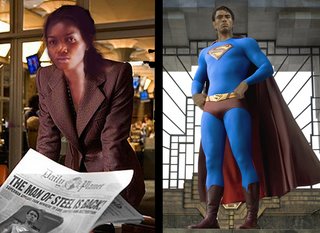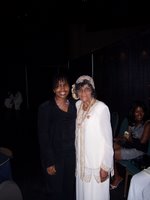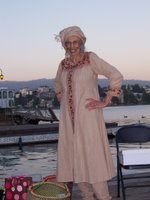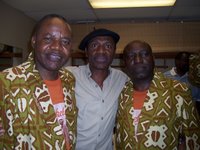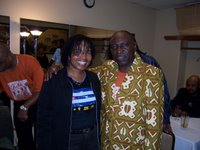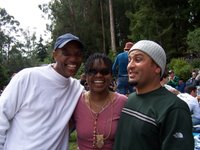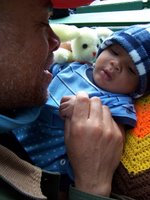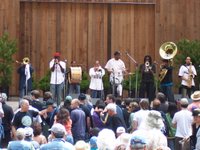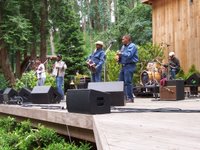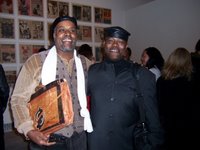



Black Panther Party Rank and File
A Review by Wanda Sabir
The foot soldier rarely gets his or her due, yet if it weren’t for what is known as the “rank and file” contingent, movements like the Black Panther Party for Self-Defense would have remained a great idea not an actual movement for social change. Co-founders: Huey P. Newton and Bobby Seale couldn’t have accomplished this broad-based effort without the brothers and sisters like Jabali who ditched school for the revolution – a “much more viable vocation,” he thought at the time when he moved here from Gary, Indiana. Ruth Beckford set up the breakfast program which fed children daily before school, while others prepared the food, collected donations – served the people in whatever capacity necessary at that moment. Parents like Elaine Brown let other party members raise her daughter, her life dedicated “to the people.”
I’m not certain if the personal sacrifice is visible in “BPP Rank and File,” which at times is unwieldy intellectually and philosophically when one tries to connect the dots or panthers as it were. Perhaps some panthers on the floor, dates, geographical markets, even thematic names of the various galleries…would have been helpful here.
The challenge in such a broad task of portraying history is finding the balance between text and design, aesthetics and content. The opening essay on the wall and an aerial drawing of key historic moments in Party history is not that helpful when looked at in the context of the larger work filling gallery after gallery.
Artist Steve Jones’ piece is about the closest to this “map” in the entire exhibition, yet even here one has to know certain things to truly appreciate the breath of his artistic vision. Nonetheless, it helps – the artist’s two dimensional landscape beginning with Newton’s birth ending with his murder – the two ends of the horizon visible markers along a finite timeline – one man’s life.
Jones’ uses this life to delineate the growth of the Black Panther Party’s key story elements – characters and scenes, like the 10-point program, Bobby Hutton and where he was shot by police, the courthouse where Huey sat while BPP members stood sentinel, dates and/or key words like “Mulford Act,” which rescinded Californian’s right to bear arms.
As already indicated, there are pieces one could miss, especially those not up on “Black Panther Party for Beginners,” which is probably most of us, so a narrative would have been helpful for this piece – to decipher the layers, digging beneath the surface to find the core Jones places in his “draft” of a movement.
There are so many unanswered questions along the precipice….Jones’ perfectly drawn lines. What happened? Why did Newton really die?
Former Minister of Culture, Emory Douglas’ rendering (within the Jones’ piece) of a party member, fist raised in salute to the path, Afro big and loud – Jones’ keen ability to chart this journey – in this case Newton’s and his Party’s, is what the exhibition:
“BPP Rank and File” is about –taking archival material and weaving it between fine art, installations and other work to show how a Brenda Presley (Oakland/San Francisco), a Shelly Sanders (Oakland/San Francisco), a Tekeba Banto (Seattle), or a James Mott (Sacramento chapter), decided to participate in a movement which gave rise to Black resistance and Black organization, direct response to Jim Crow in the north, the continued legal enslavement of Africans post-Civil War south—the institution’s name changed to shield the guilty. The BPP was an answer to the lynchings and police brutality, separate facilities, fear and repression…. What did Langston Hughes say about raisins in the sun?
Not only were Party members hip to the plight of the working class and other subjugated folk the world over, other folk were hip to the movement growing in America, a movement that appealed to the boldness of youth who wanted immediate results after watching their parents terrorized for marching, carrying signs, and singing.
The BPP rank and file members asserted their rights as citizens. Politically savvy – the leadership educated the masses well and the legacy of this was evident at the reception, Friday night, March 17, the hugs, pictures and travels along memory lane lasted well into the wee hours of the night.
Soul Salon 10 situated in one of the only enclosed spaces – what used to be a cyber-café featured the work of the ten artists on the theme of “Risk and Response.” Both here and elsewhere, there was a conscious effort at integrating genres: primary documents explaining the history of the party through rare copies of papers covering the early Black Panther Party days through the end of this amazing organization. All of the papers and other published articles on the BPP like the Gordon Parks exposé in Life Magazine, articles from the San Francisco Examiner, and other media outlets are bound in readers available for gallery patrons to read or skim. There are also listening stations throughout the multi-gallery space, with rare archival footage of Huey P. Newton and other Party members speaking about issues of the day courtesy of California Newsreel.
After circling a few times, my favorite area was the archives. I felt grounded here and after looking at the artifacts, I felt fortified and capable to venture into the more abstract areas of the exhibition.
Black Panther Party Rank and File is more than one can possibly digest in one tour, even a four hour one; this exhibition is one which requires several tours to allow certain philosophical concepts to sink in. The BPP was not a light-weight organization; people studied, and acquired knowledge applicable today.
All the party members I spoke to opening night, even those who complained a little, couldn’t help but concede Rene de Guzman and Claude Simard, co-curators, in consultation with Bill Jennings, Director of It’s About Time, the Panther Alumni Association and the BPP archive, did an excellent job in showcasing a movement many do not know much about.
Guzman stated, “The Black Panther Rank and File exhibition reflects YBCA’s ongoing commitment to highlighting the Bay Area’s significant impact on world art and politics. The struggle for social justice that characterized the turbulent ‘60s, is still prevalent today, and continues to inspire art making. This project, which brings together art and artifacts, also demonstrates how contemporary art plays a role in civic life, and provides (a) positive impact beyond the conventional confines of museum or gallery settings.”
All visitors agreed on the value of such an exhibition despite any visible weaknesses which for Brother Jabali was the absence of more Party women on the walls or present at the reception, and for Bobby Seale an unarticulated “something,” I haven’t followed up with him to get the details, now that some time has passed. For me, the thin connective tissue linking the larger concepts: black power movement to social action to political activism, to self-awareness, to self-destruction is a piece or aspect of the movement which is noticeably absent— unless the empty peacock chair akin to a vacated throne, is symbolic of this. What remains undefined or clearly articulated is the historic moment which created the Black Panther Party for Self-Defense in the first place and how this movement in turn is connected philosophically to the globalization of the Party’s influence, for instance, in work by Paa Joe, Ghanaian sculptures of coffins in the form of historic slave dungeons.
The Party is nothing else was a force, palatable, a medium on could feel and express, so why the silence?
If the BPP were this benign presence gone and now forgotten, then why are former Party members Ray Boudreaux, John Bowman, Richard Brown, Hank Jones, and Harold Taylor – torture victims, still being persecuted? Why is former Party member Aaron Dixon, Green Party, Seattle, is running a successful campaign for U.S. Senate in Washington, against first term incumbent Maria Cantwell (D-Washington)? He said when here a few months ago at an event connected to the YBCA exhibit that his platform is the same as that presented by the Party (10-Point Program). Visit www.aarondixon.org and http://www.dixon4senate.com/.
All the wheel needs is air, not reinventing.
BPP Rank and File is indicative of the political clime and mood which made it possible for a Ron Dellums to walk in the Oakland mayoral office with more than a 50 percent plus one lead. At some point the people wake up and reclaim their power, a power too easily relinquished to constituencies which did not have their interests in mind.
Even though there is no gallery which allows one to collect one’s thoughts and think about next steps, the art is nonetheless provocative and the photos a part of a collective memory as are many artists’ names. The BPP still resonates in the lives of Americans.
Whether patrons are cognizant or can “count the many ways how the BPP for Self-Defense has impacted American society as reflected in the role and presence of African people on these shores in cities like San Francisco, Oakland, Richmond, San Jose, Antioch…when they enter the gallery, remains to be seen. Yet, when they exit, the same is definitely not true.
Once visitors leave the impact is undeniable, however. One cannot deny the fact that the Black Panther Party for Self-Defense was a formidable force, a force which called American leadership -- local, state and federal into tangible accountability, which is still calling this government to accountability. Cases like of Mumia Abu Jamal (http://www.mumia.org/freedom.now/), and other Political Prisoners and Prisoners of War like Marilyn Buck, (http://www.prisonactivist.org/pps+pows/marilynbuck/), Sundiata Acoli (http://sundiata.afrikan.net/), even MOVE members still locked behind bars point to this (http://www.onamove.com/). “Black Panther Party Rank and File” gives one an inkling of the power and determination which struck fear into the institutional legs of America causing it to quake.
The exhibit closes July 2 at the Yerba Buena Center for the Arts, 701 Mission Street, San Francisco. Visit http://www.ybca.org/va/future/mar06/black_panthers.htm or call (415) 978-2787.
Photo credit: Wanda Sabir
L-R: Steve Jones, artist with Studio Museum of Harlem curator; Derethia DuVal with mother in center, and W.Sabir; Bill Jennings with Jabali (former BPP members); art from exhibit
